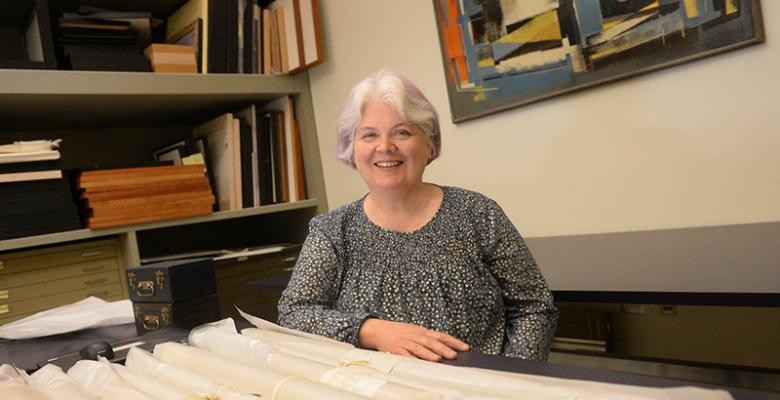CU People: Janet Parks, Curator and Archivist

Years at Columbia
43, since entering graduate school in art history in 1974.
What She Does
Parks (GSAS’76) acquires collections, handles exhibitions and answers requests from researchers around the world. \"Architecture, as shelter, is a necessary art,” she said, “so we get inquiries from the Columbia community, international scholars and architects, and many New Yorkers—because New Yorkers are obsessed with real estate.”
About 95 percent of the archive’s more than two million items were acquired under her tenure, up from 50,000 items when she began. These include architectural drawings and archival photographs, correspondence, documents and, increasingly, collections with a digital component. “New York was and is the place for major architecture firms,” she said. “It has given Columbia access to collections that matter.”
Related: Exhibition Unpacks the Gems in Frank Lloyd Wright Archive, Columbia News, June 15, 2017
What She Likes Most About the Job
The lively interchange with people who come to use the collection. “It’s great to watch the development of projects that can begin with a publication and develop into an exhibition,” she said. Most recently, Greg Goldin and Sam Lubell's book Never Built New York published many drawings from the collection, and an exhibition based on the book will open at the Queens Museum in September.
Most Memorable Moment
Moving the drawings of a leading 20th-century architect of New York City theaters, Thomas W. Lamb, from a fifth-floor dressing room at the Lyric Theater on West 42nd Street. Parks and her staff transported some 20,000 drawings by passing them hand-to-hand in a human chain of seven or eight people, including Barry Bergdoll, who was then one of her graduate student assistants and is now Columbia’s Meyer Schapiro Professor of Art History and Archaeology. The team used hammers and screwdrivers to open the tightly sealed metal tubes that held the drawings. Parks recalled that, “One that they opened smelled of aftershave and pipe smoke from decades earlier.”
Best Part of the Job
Acquiring interesting and important collections. She spent six weeks in Arizona between 2013 and 2016 packing the Frank Lloyd Wright Archives, which filled the equivalent of six tractor trailers. Soon after, emails from around the world poured in, connecting the Avery staff to “an immediate fan club that wants to write to you every day.” The Frank Lloyd Wright Conservancy has named her a 2017 recipient of a Wright Spirit Award for her role in moving the collection to Columbia.
Other notable acquisitions include the papers of Woodlawn Cemetery in the Bronx, a National Historic Landmark whose monuments were designed by some of the most admired architects of the 19th and 20th centuries. “It is both a record of growth of New York City and a singular representation of one of the greatest collections of architectural funerary monuments in the world,” Parks noted.
Parks is also interested in lesser known architects, such as Horace Ginsbern, who designed more than 20 buildings on the Grand Concourse, often called the Champs-Élysées of the Bronx.
In deciding whose collections to accept, Parks often asks herself: “Was the firm well known? Was the building type widely built? Did it affect a lot of people?”
Road to Columbia
Parks grew up in Columbus, Ohio, studied at Vassar College and then earned a master’s degree in art history at Columbia in 1976.
In Her Spare Time
A sports fan, Parks has played in amateur squash tournaments for years. After she retires this month, Parks will advise professionals on architectural archives and pursue her own writing and research projects.
She is a guest curator of Frank Lloyd Wright at 150: Unpacking the Archive, a joint exhibition of Avery Library and the Museum of Modern Art, which is on view at the museum through October 1.